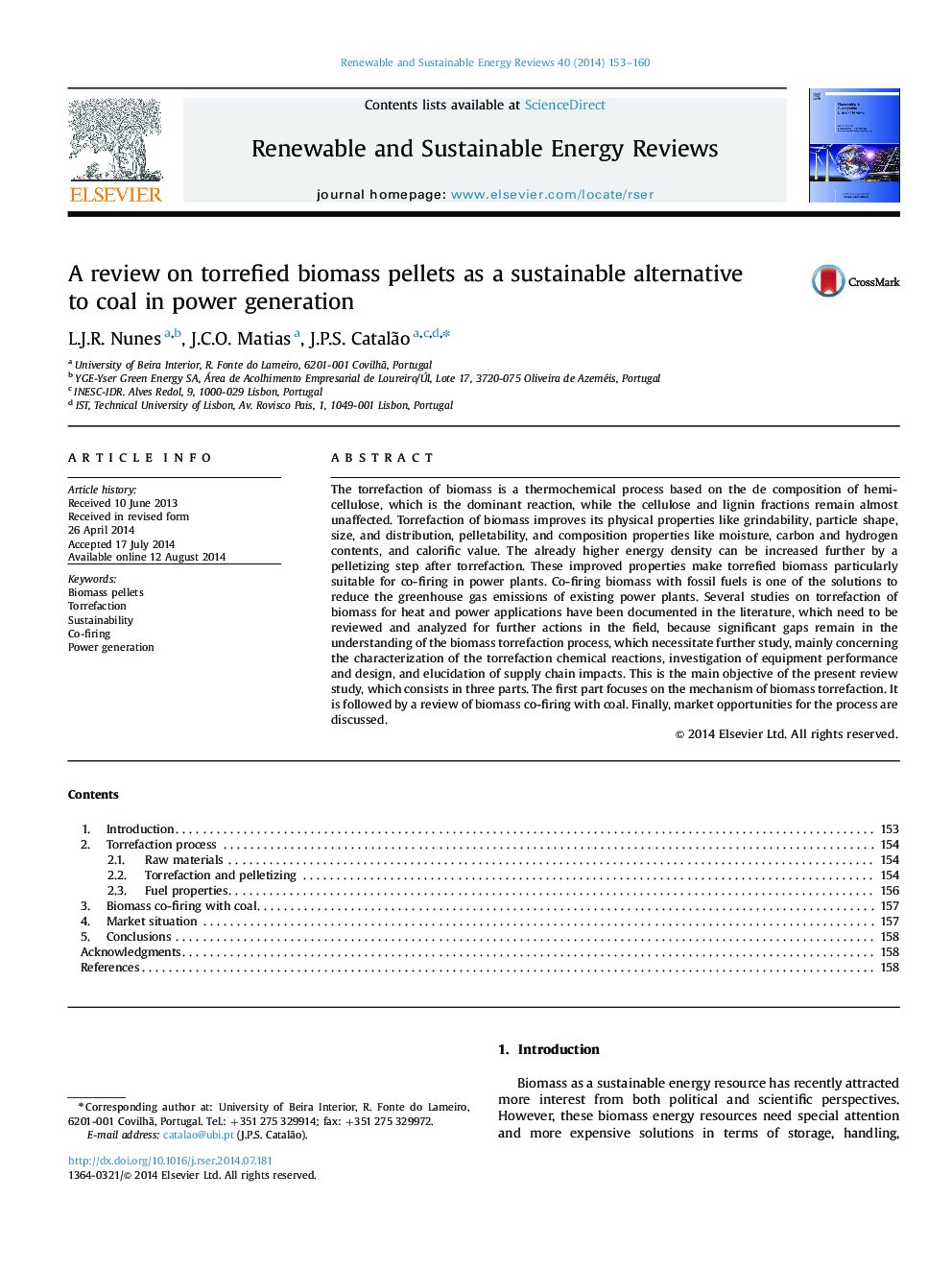| کد مقاله | کد نشریه | سال انتشار | مقاله انگلیسی | نسخه تمام متن |
|---|---|---|---|---|
| 8118488 | 1522345 | 2014 | 8 صفحه PDF | دانلود رایگان |
عنوان انگلیسی مقاله ISI
A review on torrefied biomass pellets as a sustainable alternative to coal in power generation
ترجمه فارسی عنوان
بازبینی بر روی گلوله های زیست توده ای به عنوان یک جایگزین پایدار برای زغال سنگ در تولید برق
دانلود مقاله + سفارش ترجمه
دانلود مقاله ISI انگلیسی
رایگان برای ایرانیان
کلمات کلیدی
گلوله های زیست توده، تورفتگی، پایداری، آتش سوزی، تولید برق،
ترجمه چکیده
فرسایش زیست توده یک فرآیند ترمو شیمیایی است که براساس ترکیب ترکیبات همی سلولز که واکنش غالب است، در حالی که فسیل های سلولز و لیگنین تقریبا بدون تأثیر هستند. تراکم زیست توده باعث بهبود خواص فیزیکی آن مانند تراکم، شکل ذرات، اندازه و توزیع، گرانشی و خواص ترکیبی مانند رطوبت، کربن و هیدروژن و ارزش کالری می شود. تراکم انرژی در حال حاضر بالاتر می تواند با یک مرحله گلوله سازی پس از فرسایش افزایش یابد. این خواص بهبود یافته باعث ایجاد زباله های فرسوده شده به ویژه برای شلیک همزمان در نیروگاه ها می شود. زیست توده همراه با سوخت های فسیلی یکی از راه حل های کاهش انتشار گازهای گلخانه ای نیروگاه های موجود می باشد. مطالعات متعددی در مورد فرسایش زیست توده برای کاربردهای گرما و قدرت در ادبیات ثبت شده است، که باید برای اقدامات بیشتر در این زمینه مورد بررسی و تحلیل قرار گیرد، زیرا شکاف قابل توجهی در درک فرآیند فرسایش زیست توده ای وجود دارد که نیاز به مطالعه بیشتر دارد، عمدتا در مورد ویژگی های واکنش های شیمیایی ریزش مو، تحقیق در مورد عملکرد و طراحی تجهیزات و توضیح اثرات زنجیره تامین. این هدف اصلی مطالعه حاضر بررسی است که شامل سه بخش است. قسمت اول تمرکز بر مکانیزم فرسایش زیست توده است. به دنبال بررسی سوخت زیست توده با زغال سنگ است. در نهایت، فرصت های بازار برای این روند مورد بحث قرار می گیرد.
موضوعات مرتبط
مهندسی و علوم پایه
مهندسی انرژی
انرژی های تجدید پذیر، توسعه پایدار و محیط زیست
چکیده انگلیسی
The torrefaction of biomass is a thermochemical process based on the de composition of hemicellulose, which is the dominant reaction, while the cellulose and lignin fractions remain almost unaffected. Torrefaction of biomass improves its physical properties like grindability, particle shape, size, and distribution, pelletability, and composition properties like moisture, carbon and hydrogen contents, and calorific value. The already higher energy density can be increased further by a pelletizing step after torrefaction. These improved properties make torrefied biomass particularly suitable for co-firing in power plants. Co-firing biomass with fossil fuels is one of the solutions to reduce the greenhouse gas emissions of existing power plants. Several studies on torrefaction of biomass for heat and power applications have been documented in the literature, which need to be reviewed and analyzed for further actions in the field, because significant gaps remain in the understanding of the biomass torrefaction process, which necessitate further study, mainly concerning the characterization of the torrefaction chemical reactions, investigation of equipment performance and design, and elucidation of supply chain impacts. This is the main objective of the present review study, which consists in three parts. The first part focuses on the mechanism of biomass torrefaction. It is followed by a review of biomass co-firing with coal. Finally, market opportunities for the process are discussed.
ناشر
Database: Elsevier - ScienceDirect (ساینس دایرکت)
Journal: Renewable and Sustainable Energy Reviews - Volume 40, December 2014, Pages 153-160
Journal: Renewable and Sustainable Energy Reviews - Volume 40, December 2014, Pages 153-160
نویسندگان
L.J.R. Nunes, J.C.O. Matias, J.P.S. Catalão,
